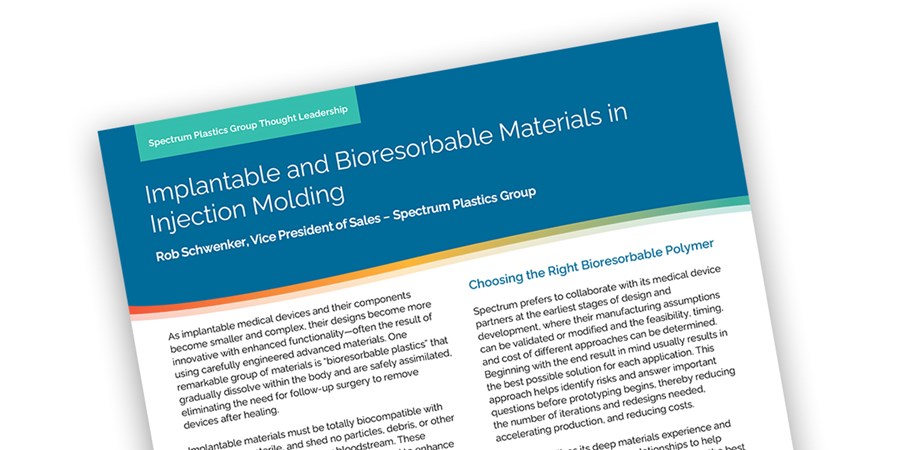Implantable and Bioresorbable Materials in Injection Molding

Implantable and Bioresorbable Materials in Injection Molding

Click here to download the thought leadership.
Rob Schwenker, Vice President of Sales - Spectrum Plastics Group
As implantable medical devices and their components become smaller and complex, their designs become more innovative with enhanced functionality—often the result of using carefully engineered advanced materials. One remarkable group of materials is “bioresorbable plastics” that gradually dissolve within the body and are safely assimilated, eliminating the need for follow-up surgery to remove devices after healing.
Implantable materials must be totally biocompatible with human tissue, sterile, and shed no particles, debris, or other contaminants into the tissues or bloodstream. These materials can also be designed and structured to enhance osseointegration and repel bacteria and infection. In fact, some specialty implantables contain embedded antimicrobial agents throughout the entire implant that repel infection—these agents are continuously released in low levels as the product breaks down, providing longer-term protection against infection.
Spectrum Plastics Group has decades of specialized expertise in developing and processing the full range of bioresorbable materials, as well as other engineered materials approved for implantation. Popular bioresorbable polymers include PLLA and PLA-like derivatives such as PLD, PLDL, PLC, PLG, PLDL, PDLG, PG, PLGA). Other common materials are TPU, PC, ABS, PEI, PSU, PPSU, and PEEK.
Because they are sensitive materials, bioresorbables can be susceptible to environmental factors during injection molding, such as temperature fluctuations and moisture. They must be handled and processed with care to prevent any structural or chemical degradation that could impact performance, from the time the material arrives at the facility to the moment the final injection molded component are shipped to the customer. For environmental and sustainability reasons, biomaterials are also a good choice over standard plastics because they break down much more easily.
We’re happy to help with your projects in any way we can. Contact us and we’ll email you back the information you’re looking for, or we’ll schedule a call to discuss with you in more detail.


Spectrum prefers to collaborate with its medical device partners at the earliest stages of design and development, where their manufacturing assumptions can be validated or modified and the feasibility, timing, and cost of different approaches can be determined. Beginning with the end result in mind usually results in the best possible solution for each application. This approach helps identify risks and answer important questions before prototyping begins, thereby reducing the number of iterations and redesigns needed, accelerating production, and reducing costs.
Spectrum utilizes its deep materials experience and outstanding material vendor relationships to help medical device manufacturers (MDMs) select the best material for their projects. Our input is most effective when Spectrum engineers share their expertise and knowledge throughout the design for manufacturability (DFM) process. It is absolutely critical to completely understand the expected end-use of the product. Some implantable devices are bioresorbable; others are not. Many require high-temperature processing, which can cause increased wear on the tools and material degradation if not monitored properly. Being involved in the earliest DFM stages allows us to validate a wide range of manufacturability assumptions and develop precise costing, timing, and feasibility data to make the best-informed manufacturing decisions.
Bioresorbable materials are used in a variety of molded medical devices, especially for cardiology, oncology, neurology, orthopedics, cosmetic surgery, sports medicine, trauma, and surgical instrumentation. These products include components for knee, hip, shoulder, hammer toe, and other extremity replacements or implants and cosmetic procedures.
Bioresorbables are also ideal for sutures, anchors, and screws. Bioresorbable fixation devices remove steps from ligament reattachment, small vessel anastomosis, nerve reconstruction, and cranial maxillofacial procedures.
Applications for bioresorbable polymers include:
In many cases, implantable products are more difficult to process and manufacture. Bioresorbable materials are especially sensitive to temperature and moisture, which means the entire handling process must be carefully planned out. This begins when the raw materials arrive and continues through material drying, molding the product, packaging, sterilization, and shipping the final product. It is critical to maintain a highly consistent process throughout production, packaging, and delivery to the end user. For design and development, there is limited available data that indicates how to process materials. This is specialized expertise that Spectrum has developed over decades of making medical devices. Our advanced quality and inspection systems manage all customer regulatory requirements, handle documentation and traceability, and monitor and document all key parameters during production.
The key objective of a bioresorbable product is being safely absorbed into the patient. The targeted absorption rate—whether it is 12 months or four years—is often the primary factor in material selection and also depends on the application. The actual geometry of a part also plays a critical role.
Application of too much heat during the injection process, or exposing the material to heat over too long a time, can degrade long-term performance of the material. Likewise, materials can also be easily damaged by improper handling, exposure to moisture, or improper storage. Failure to maintain quality control can lead to a lower molecular weight and reduced strength, undermining the part’s stability and longevity.
Because bioresorbables have very high viscosity, excessive shear can destroy the integrity of the material during processing. Even for mold design, design engineers must understand how the product behaves throughout the runner system. Therefore, the entire molding process must be carried out in a controlled environment (possibly cleanroom) that is managed by a robust quality system.
What often surprises MDMs is the complexity of the shipping and sterilization process. Packaging and sterilization are especially critical for bioresorbable components made from sensitive materials. For some applications, performance packaging is required to assure absolute safety. It is also essential to discuss packaging and sterilization up front in the DFM stage.
Spectrum continues to develop innovative methods for processing a variety of highly-engineered resins in deployment devices and tools. We are also at the forefront of the trend of replacing metal components with plastic parts that provide the same physical and chemical properties, but are lighter in weight and can potentially reduce the cost of a device.
Spectrum Plastic Group values works closely with MDMs as a trusted biomaterial advisor, provider, and contract manufacturer to develop and manufacture their bioresorbable deployment devices or implants. Contact us to see how our deeply experienced on-staff material scientists can support material selection and polymer formulation for your next medical device application.